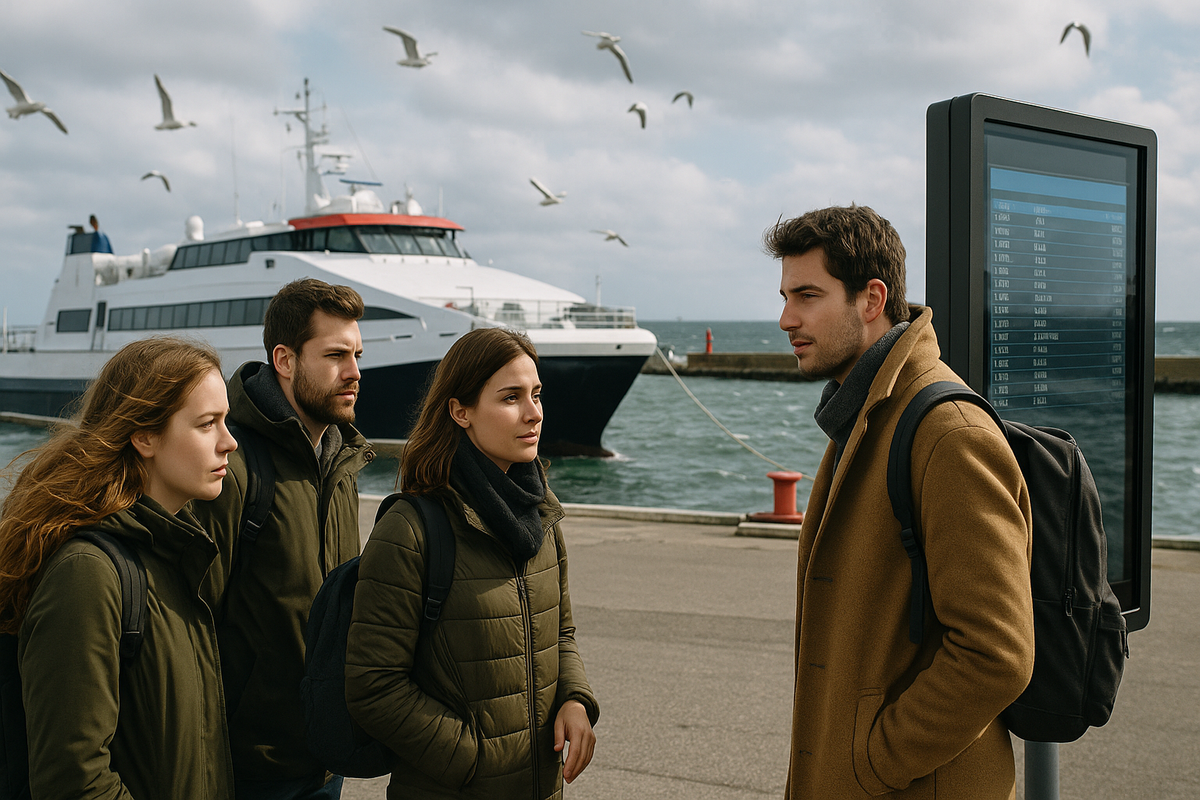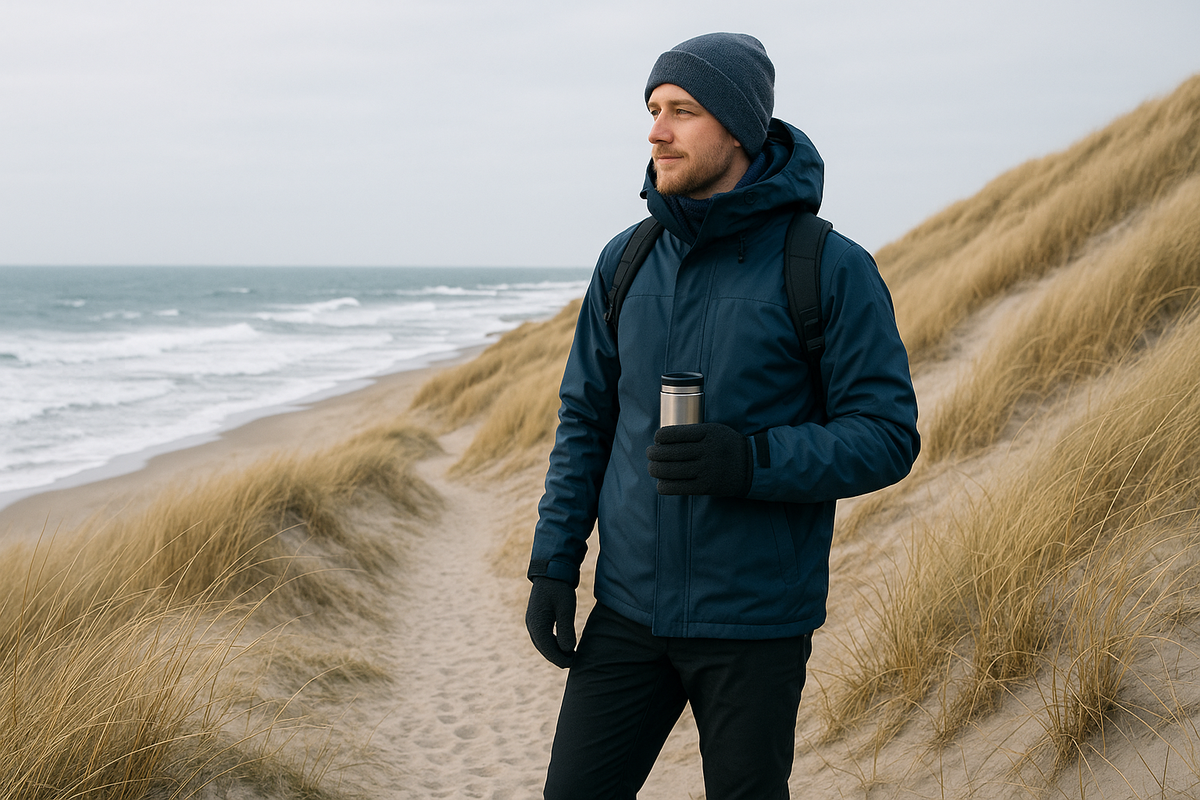🌪️ Western Jutland in autumn and winter: storm watching and how to add an extra day
Autumn-winter West Jutland is not a ’beach failure" but a separate scene: long dunes, lighthouses, the grey North Sea and wind that you can literally feel physically. People come here not for sun loungers, but for the feeling of the elements: storm watching, searching for amber after a storm, hot coffee in a café overlooking the raging ocean. 🍂
But such a trip has its price: the road along the coast, local ferries, possible flight cancellations and days when going out to the water is simply dangerous.
Therefore, a sensible itinerary for West Jutland in autumn and winter is always 3-5 days, a car if possible, and a mandatory ‘+1 day’ in case the weather decides for you.
🌬️ Autumn-winter on the North Sea: when the storms are strongest and where to go

🌧️ Why the cold season
From late October to March, the west coast of Jutland is buffeted by westerly and north-westerly winds. The waves are higher, storms are more frequent, and on the dunes and beaches you can clearly see how the North Sea works: a jagged line of breakers, foam, and noise that even a thick cap cannot drown out. This is the perfect window for those who want to:
- see the sea not as a ‘postcard’ but as alive and aggressive;
- walk among the dunes and lighthouses in almost deserted landscapes;
- catch the rare winter sun and the very photogenic low sky.
🗺️ Main storm-watching areas
Without turning this text into a beach catalogue, we can highlight several areas around which it is convenient to build a base:
- National Park Thy and Cold Hawaii (Klitmøller, Vorupør)
- Denmark's surfing corner: long beaches, powerful waves, good viewing points on the dunes and breakwaters. A classic for storm watching.
- Nordvestkysten: Hanstholm, Løkken, Lønstrup, Rubjerg Knude
- Lighthouses, cliffs, shifting dunes and long sandy beaches. Here, the storm is visible across the entire horizon, and the wind has plenty of room to blow.
- Further south, towards the Wadden Sea
- Some of the routes turn into an amber hunt: after a strong storm, the tide washes ‘gifts’ ashore, if you're lucky. 🌊🧡
It is important to understand that storm watching does not mean standing at the very edge of the water. The safe format is dunes, observation decks, lighthouses and embankments where the waves do not reach.
🚗 Route for 3–5 days: bases, car and the mandatory ‘plus one day’

📆 Why exactly 3–5 days
Less than three days — you will only have time to ‘arrive and leave,’ without having time to catch the storm or wait it out in a warm place.
The 3–5 day format allows you to:
- occupy one or two accommodation bases (for example, the Thy area + the Nordvestkysten section);
- adjust to the forecast (move closer to the expected storm or, conversely, move to a calmer area);
- calmly set aside a buffer day in case the roads/ferries are blocked.
🚘 Do you need a car
Honest answer:
- Without a car, you can live in one of the towns (Hvide Sande, Thisted, Hirtshals, etc.) and take day trips to the surrounding areas.
- With a car, you can turn your trip into a building block: change your base if the forecast changes; combine a lighthouse, dunes and a museum in one day; don't depend on infrequent bus services during a windy week.
If your goal is storm watching, rather than ‘spending a night by the sea,’ a car gives you a critical advantage in terms of flexibility.
🧭 Approximate logic of a 3-5-day itinerary
This is not a detailed guide, but a framework from which it is convenient to dance:
| 📋 Format | 📍 Base(s) | 🧭 Day outline |
|---|---|---|
| 📆 3 days | 1 base (for example, Thy / Klitmøller area) | Day 1 — arrival and first walk to the sea; Day 2 — storm watching + dunes/lighthouse; Day 3 — buffer / drive with stops |
| 📆 4 days | 1–2 bases | Plus one more “storm day” or a move to another stretch of coast (Løkken, Rubjerg Knude) |
| 📆 5 days | 2 bases (north + a more southern stretch) | Alternating a “raw” day by the sea and a calmer day with museums/aquariums, plus one full buffer day |
💡 Practical advice: Do not schedule a critical flight or long-distance train journey in the morning after your last night at the seaside. It is more logical to return inland the day before and spend your last night closer to a major transport hub.
⚓ Logistics and risks: storms, cancellations and flexible fares

🌊 How storms affect schedules
In case of strong winds and storm warnings, the following are at risk:
- Ferries — both domestic lines (small crossings to islands) and international routes to Norway, the Faroe Islands, etc.;
- Railways and buses — during floods in low-lying areas, line breaks due to wind, icing;
- Airports — delays and cancellations, especially regional flights.
The scenario is always the same: you planned to travel/fly, but in the morning you find out that your flight has been delayed by 6–12 hours or postponed until tomorrow.
📑 Why do you need ‘+1 day’ and what to do with fares
The logic behind the buffer day is simple:
- if everything goes according to plan, you simply get another day at the seaside or in a city along the way;
- if not, this day takes care of the delay, not your flight home.
Useful in advance:
- take flexible fares for ferries/trains/planes where possible;
- read the basic conditions for refunds in case of weather cancellations (usually a full refund or rebooking on the next flight);
- have minimum insurance covering delays, additional overnight stays and missed segments of the route.
💼 Mini cheat sheet on logistics:
- do not ‘tie’ the ferry to an international flight too closely;
- do not plan two critical segments on one stormy day (e.g. ferry + plane);
- have a list of the nearest towns where you can stay overnight in an emergency if the roads are closed.
🏠 Plan B for stormy days and safety on the coast

☔ What to do if you can't go to the beach
A stormy day is not necessarily a lost day if you know in advance that there are indoor alternatives:
- Museums and aquariums. Maritime history, shipwrecks, aquariums with inhabitants of the North Sea, interactive exhibitions for children. A good way to ‘formally’ stay close to the sea, but physically — in the warmth.
- Water parks and sports centres. The classic Scandinavian format: a cottage by the sea + a few hours at a water park or sports complex when it's windy and rainy outside.
- Gastronomy and local products. Whisky and beer tastings, farm shops, fish restaurants, cafes with views of the raging water. This is when the word hygge ceases to be marketing and becomes a matter of survival. 🔥
🦺 Basic safety checklist for storm season
Autumn and winter on the west coast are beautiful, but safety rules are taken seriously here:
- do not go close to the water in strong winds, do not climb on wet concrete breakwaters and wave barriers;
- respect fences and signs: if an area is closed, it's not ‘overcautious’, it's a real risk;
- during a storm, don't drive your car directly onto the beach, even if half the locals are there in dry weather — sand and water can change the terrain in a matter of hours;
- Keep your phone charged and download offline maps of your chosen region in advance.
- Think about a ‘warm base’: the nearest place where you can quickly get out of the wind (a café, museum, hotel).
🧣 Mini checklist for equipment

For autumn–winter in West Jutland, it is wise to pack:
- a windproof and waterproof jacket;
- warm layers to wear underneath (fleece/wool, not just cotton);
- waterproof shoes with treads;
- hat, gloves, buff/scarf;
- thermos with a hot drink in the boot or backpack.
In conclusion, West Jutland in autumn and winter is a special trip ‘for the weather’, not a casual ‘day trip to the sea’. If you are prepared for the wind, know how to work with the forecast and allow an extra day for logistics, storm watching becomes not a stressful experience, but one of the most memorable North Sea experiences.
❓FAQ
💡 It is best to plan your trip from late October to March, when storms and strong winds are most frequent.
💡 A reasonable minimum is 3 days, and a comfortable format is 4-5 days with one spare day for weather surprises.
💡 A car is not essential, but it makes it much easier to visit lighthouses, dunes and different parts of the coast in one trip.
💡 The extra day serves as a buffer in case of ferry cancellations, train delays or motorways closed due to storms.
💡 It is safe to watch the storm if you stay on the dunes and viewing points, do not approach the water's edge and follow local warnings.





0 comments
Log in to leave a comment